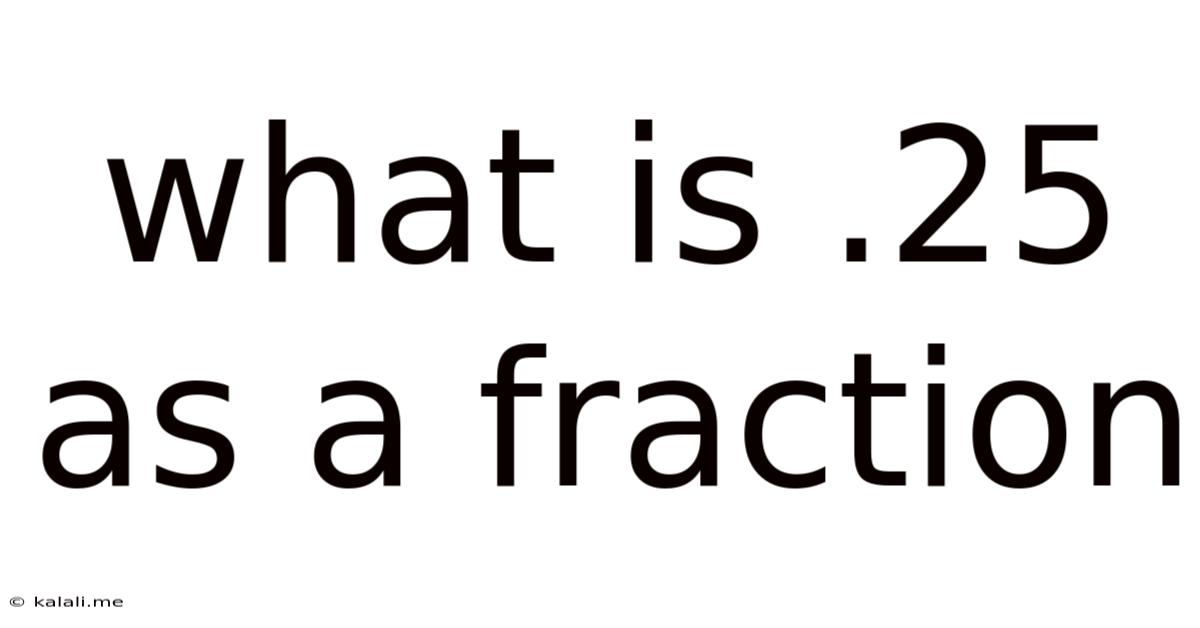What Is .25 As A Fraction
Kalali
Apr 23, 2025 · 4 min read

Table of Contents
What is 0.25 as a Fraction? A Comprehensive Guide
Understanding decimal-to-fraction conversions is a fundamental skill in mathematics. This comprehensive guide will explore the conversion of the decimal 0.25 into its fractional equivalent, offering multiple methods and delving into the broader concepts involved. We'll explore not only the solution but also the underlying principles, providing a solid foundation for understanding similar conversions. This will be particularly useful for students, educators, and anyone seeking a deeper understanding of fractions and decimals.
What is a Decimal?
Before diving into the conversion, let's briefly review what decimals represent. Decimals are a way of expressing numbers that are not whole numbers. They use a base-ten system, where each digit to the right of the decimal point represents a power of ten. For instance, in the number 0.25, the '2' represents two-tenths (2/10), and the '5' represents five-hundredths (5/100).
Converting 0.25 to a Fraction: The Simple Method
The easiest way to convert 0.25 to a fraction is to recognize that 0.25 represents 25 hundredths. This can be directly written as a fraction:
25/100
This fraction is already a valid representation of 0.25, but we can simplify it further.
Simplifying Fractions: Finding the Greatest Common Divisor (GCD)
To simplify a fraction, we need to find the greatest common divisor (GCD) of the numerator (25) and the denominator (100). The GCD is the largest number that divides both the numerator and the denominator without leaving a remainder. In this case, the GCD of 25 and 100 is 25.
Dividing the Numerator and Denominator by the GCD
To simplify the fraction 25/100, we divide both the numerator and the denominator by their GCD (25):
25 ÷ 25 = 1 100 ÷ 25 = 4
Therefore, the simplified fraction is:
1/4
Therefore, 0.25 as a fraction is 1/4.
Alternative Methods for Conversion
While the above method is the most straightforward, let's explore alternative approaches that reinforce the understanding of decimal-to-fraction conversions:
Method 2: Using Place Value
We can analyze the place value of each digit in the decimal 0.25. The '2' is in the tenths place, and the '5' is in the hundredths place. This allows us to write 0.25 as:
(2 × 1/10) + (5 × 1/100)
Simplifying this expression:
2/10 + 5/100
To add these fractions, we need a common denominator, which is 100:
(20/100) + (5/100) = 25/100
This again simplifies to 1/4.
Method 3: Multiplying by a Power of 10
Another approach involves multiplying the decimal by a power of 10 to remove the decimal point. Since there are two digits after the decimal point, we multiply by 100:
0.25 × 100 = 25
Now, we write this as a fraction with a denominator of 100:
25/100
And, as shown before, this simplifies to 1/4.
Understanding the Concept of Equivalence
It's crucial to understand that 0.25, 25/100, and 1/4 are all equivalent representations of the same value. They are different ways of expressing the same proportion or part of a whole. The simplification process ensures we use the most concise and efficient representation of the fraction.
Practical Applications of Decimal to Fraction Conversions
Understanding how to convert decimals to fractions is essential in various practical applications, including:
- Cooking and Baking: Recipes often use fractions for ingredient measurements, so converting decimal amounts to fractions ensures accuracy.
- Construction and Engineering: Precise measurements are vital, and converting decimals to fractions ensures accuracy in calculations.
- Finance: Understanding percentages and proportions involves working with both decimals and fractions.
- Science and Research: Data analysis often involves converting between decimals and fractions for calculations and representation.
Further Exploration: Converting Other Decimals to Fractions
The methods described above can be applied to convert other decimals to fractions. For example:
- 0.75: This can be written as 75/100, which simplifies to 3/4.
- 0.125: This can be written as 125/1000, which simplifies to 1/8.
- 0.6: This can be written as 6/10, which simplifies to 3/5.
The key is to write the decimal as a fraction with a power of 10 as the denominator and then simplify the fraction by finding the GCD of the numerator and denominator.
Dealing with Recurring Decimals
Converting recurring decimals (decimals with repeating digits) to fractions requires a slightly different approach, often involving algebraic manipulation. This is a more advanced topic, but understanding the basic principles of converting terminating decimals to fractions provides a solid foundation for tackling more complex conversions.
Conclusion:
Converting 0.25 to a fraction is a straightforward process with several approaches to achieve the same result: 1/4. Understanding the underlying concepts of decimals, fractions, and simplification techniques is crucial for mastering this fundamental mathematical skill. This knowledge extends beyond simple conversions and proves invaluable across various fields, reinforcing the importance of a strong foundation in mathematical principles. Remember to always simplify your fractions to their lowest terms for the most efficient representation. This comprehensive guide offers a robust understanding of this concept, laying the groundwork for tackling more advanced mathematical challenges.
Latest Posts
Latest Posts
-
Cuantos Grados Celsius Son 50 Fahrenheit
Apr 23, 2025
-
Is The Pacific Ocean Warmer Than The Atlantic
Apr 23, 2025
-
What Is 2 To The 10th Power
Apr 23, 2025
-
How Many Ounces Are 200 Grams
Apr 23, 2025
-
What Is 67 Inches In Cm
Apr 23, 2025
Related Post
Thank you for visiting our website which covers about What Is .25 As A Fraction . We hope the information provided has been useful to you. Feel free to contact us if you have any questions or need further assistance. See you next time and don't miss to bookmark.